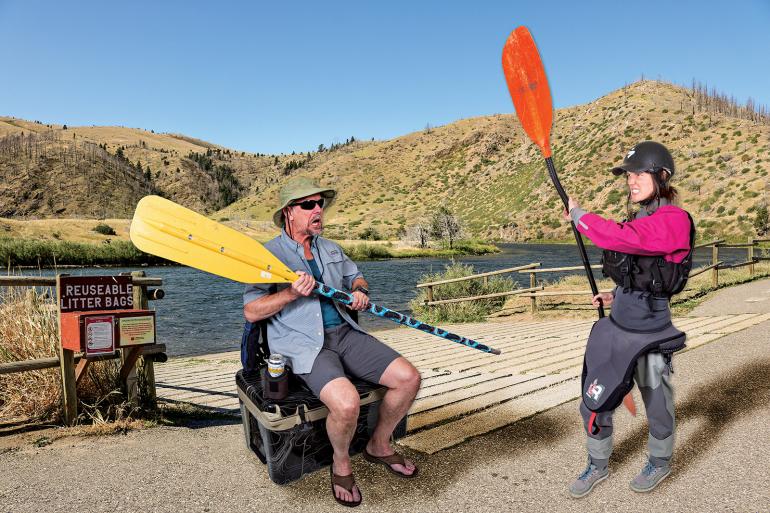Face-Off: Kayaking Vs. Rafting
A water fight for the ages.
Over the years, choices in watercraft have expanded tremendously. No longer are we limited to the hand-carved canoes of yore, however cool they may be. Design and material innovations have allowed the modern-day river rat to choose from a plethora of vessels, each offering a unique aqua-experience. This season, we’re breaking down two of them in a no-holds-barred, river-running face-off to find out once and for all who the water gods shine down on the brightest. We’ve got rubber and plastic, oars and paddles. Look out, folks, it’s raft versus kayak.
Convenience
Regardless of downstream device, space is a consideration. If you’ve got a raft with an oar frame, you’d better have a trailer, a roof rack, and/or a full-sized truck bed for transport. But toting around a seven-foot, 60-pound hunk of plastic comes with its own issues. At the end of the day, size matters—inversely, in this case. A typical raft outing requires more equipment, logistics, and time than kayaking does. In the time that it takes to rig up the boat, get it in the water, and sort all the gear, you could’ve paddled two Mad Mile laps.
Edge: Kayak
Learning Curve
Safe navigation of Montana rivers is not something easily mastered, but different crafts require different skillsets. With rafting, it’s figuring out how to maneuver a lumbering vessel with a turning radius the size of a Bozeman roundabout. Kayaking, on the other hand, demands a repository of core strength and dynamic movements to maintain stability. Not to mention knowing how to roll back up if (read: when) you flip over—unless you’d rather force your friends to rescue you and your boat, every damn time. Mistakes in the early stages of rafting result in bumping into boulders, missing eddies, and spilling beers; a flipped raft is rare, the result of a major screw-up. Learning how to kayak, on the other hand, means swimming, and often, sometimes through terrifying stretches of river. This one’s no contest.
Edge: Raft
Whitewater
This category is tough, because frothy waves, surging hydraulics, and big drops are just plain fun, no matter the craft. But let’s look at it through an expert’s eye. The amount of water accessible to a paddler is far greater than the number of rapids that can be run on a raft (Big Timber Creek, anyone?). Rowing a raft has been likened to driving a bus, while paddling a kayak is more akin to handling a sportscar. Sure, they each have their pros and cons, but which one would you want for the Indy 500? Yep, us too.
Edge: Kayak
Comfort
Now, rafts may have lost in the Convenience category, but it wasn’t for nothing. All the hassle that comes with putting a big boat in the water is offset by its maximized relaxation. This means an elevated view, cushioned seat, the ability to move around, and a beer at arm’s length. Compare that to forcing your body into an awkward frog shape and sealing yourself in with a tight-fitting neoprene skirt.
Edge: Raft
Versatility
At first glance, this seems like a clear decision. Kayaks are smaller, easier to transport, and have a greater range than rafts. But, while rafts lose points with their bulk, they make up for it with the number of additional activities possible. With a big boat, you can fish, run whitewater, and party-barge all in the same day—heck, all at the same time, in some cases. Kayakers are more or less limited to one of these activities. Further inspection makes this one too close to call.
Edge: Tie
Cost
As with most other outdoor endeavors, the price to participate has done nothing but rise. Sad as it is, you’ll be hard-pressed to get into watersports for under $1,000. Some of the new whitewater kayaks are up to $1,700 alone! That said, you’re looking at $3,500 for a 14-foot raft. And that’s on the low end. Add another grand for the frame, plus a couple more for oars and a trailer. Oofda. When is payday again?
Edge: Kayak
Social Factor
One of the best things about recreating on the water is enjoying it with other people. Kayakers are a close-knit bunch, and running rapids in tandem with your buddies is hard to beat. But the intimacy level is different on a raft. Being in the same craft as your companions cultivates a shared experience unlike any other activity. It’s not uncommon for a group of kayakers to be separated for a majority of the time. But on a raft, everyone is in it together for the entire river stretch, whether they’re pounding frothy waves or frothy beer.
Edge: Raft
Score: 3-3
Winner: Tie
After seven stressful rounds, we can’t call a clear victor. It appears the real winner is river-running in general. So, pick your passion; our analysis indicates that you can’t go wrong.




























